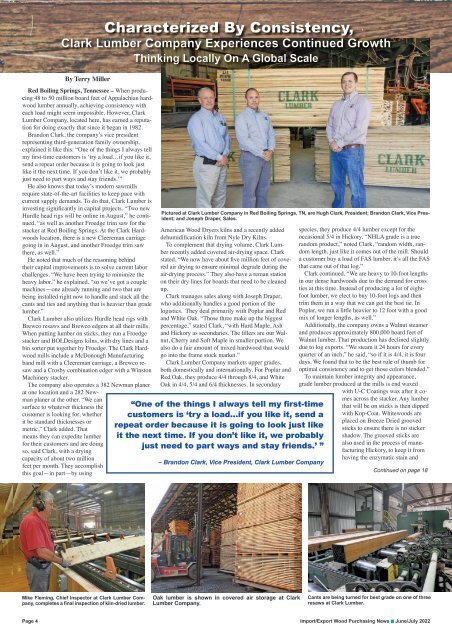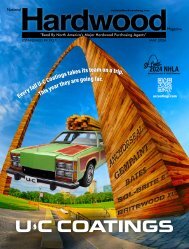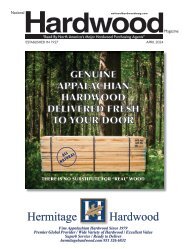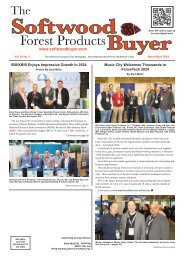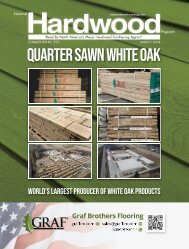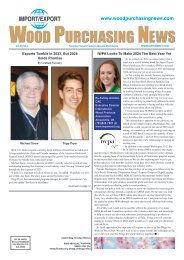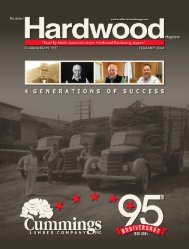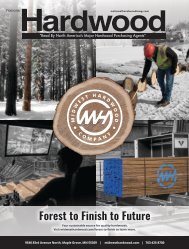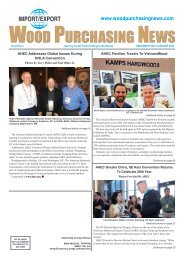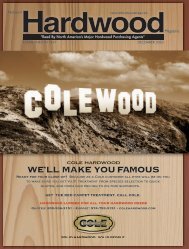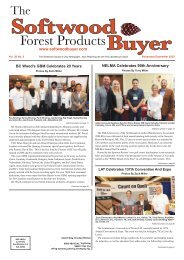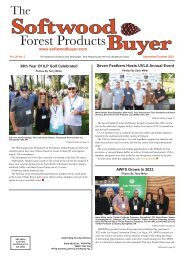Import/Export Wood Purchasing News - June- July 2022
Get updates from the IWPA World of Wood Convention, the AHEC Hardwood Pavilion in Spain, and the Dubai WoodShow in the latest issue of Import/Export Wood Purchasing News.
Get updates from the IWPA World of Wood Convention, the AHEC Hardwood Pavilion in Spain, and the Dubai WoodShow in the latest issue of Import/Export Wood Purchasing News.
You also want an ePaper? Increase the reach of your titles
YUMPU automatically turns print PDFs into web optimized ePapers that Google loves.
Characterized By Consistency,<br />
Clark Lumber Company Experiences Continued Growth<br />
Thinking Locally On A Global Scale<br />
By Terry Miller<br />
Red Boiling Springs, Tennessee – When producing<br />
48 to 50 million board feet of Appalachian hardwood<br />
lumber annually, achieving consistency with<br />
each load might seem impossible. However, Clark<br />
Lumber Company, located here, has earned a reputation<br />
for doing exactly that since it began in 1982.<br />
Brandon Clark, the company’s vice president<br />
representing third-generation family ownership,<br />
explained it like this: “One of the things I always tell<br />
my first-time customers is ‘try a load…if you like it,<br />
send a repeat order because it is going to look just<br />
like it the next time. If you don’t like it, we probably<br />
just need to part ways and stay friends.’”<br />
He also knows that today’s modern sawmills<br />
require state-of-the-art facilities to keep pace with<br />
current supply demands. To do that, Clark Lumber is<br />
investing significantly in capital projects. “Two new<br />
Hurdle head rigs will be online in August,” he continued,<br />
“as well as another Froedge trim saw for the<br />
stacker at Red Boiling Springs. At the Clark Hardwoods<br />
location, there is a new Cleereman carriage<br />
going in in August, and another Froedge trim saw<br />
there, as well.”<br />
He noted that much of the reasoning behind<br />
their capital improvements is to solve current labor<br />
challenges. “We have been trying to minimize the<br />
heavy labor,” he explained, “so we’ve got a couple<br />
machines—one already running and two that are<br />
being installed right now to handle and stack all the<br />
cants and ties and anything that is heavier than grade<br />
lumber.”<br />
Clark Lumber also utilizes Hurdle head rigs with<br />
Brewco resaws and Brewco edgers at all their mills.<br />
When putting lumber on sticks, they run a Froedge<br />
stacker and BOLDesigns kilns, with dry lines and a<br />
bin sorter put together by Froedge. The Clark Hardwood<br />
mills include a McDonough Manufacturing<br />
band mill with a Cleereman carriage, a Brewco resaw<br />
and a Crosby combination edger with a Winston<br />
Machinery stacker.<br />
The company also operates a 382 Newman planer<br />
at one location and a 282 Newman<br />
planer at the other. “We can<br />
surface to whatever thickness the<br />
customer is looking for, whether<br />
it be standard thicknesses or<br />
metric,” Clark added. That<br />
means they can expedite lumber<br />
for their customers and are doing<br />
so, said Clark, with a drying<br />
capacity of about two million<br />
feet per month. They accomplish<br />
this goal—in part—by using<br />
Pictured at Clark Lumber Company in Red Boiling Springs, TN, are Hugh Clark, President; Brandon Clark, Vice President;<br />
and Joseph Draper, Sales.<br />
American <strong>Wood</strong> Dryers kilns and a recently added<br />
dehumidification kiln from Nyle Dry Kilns.<br />
To complement that drying volume, Clark Lumber<br />
recently added covered air-drying space. Clark<br />
stated, “We now have about five million feet of covered<br />
air drying to ensure minimal degrade during the<br />
air-drying process.” They also have a reman station<br />
on their dry lines for boards that need to be cleaned<br />
up.<br />
Clark manages sales along with Joseph Draper,<br />
who additionally handles a good portion of the<br />
logistics. They deal primarily with Poplar and Red<br />
and White Oak. “Those three make up the biggest<br />
percentage,” stated Clark, “with Hard Maple, Ash<br />
and Hickory as secondaries. The fillers are our Walnut,<br />
Cherry and Soft Maple in smaller portion. We<br />
also do a fair amount of mixed hardwood that would<br />
go into the frame stock market.”<br />
Clark Lumber Company markets upper grades,<br />
both domestically and internationally. For Poplar and<br />
Red Oak, they produce 4/4 through 8/4, and White<br />
Oak in 4/4, 5/4 and 6/4 thicknesses. In secondary<br />
“One of the things I always tell my first-time<br />
customers is ‘try a load…if you like it, send a<br />
repeat order because it is going to look just like<br />
it the next time. If you don’t like it, we probably<br />
just need to part ways and stay friends.’ ”<br />
– Brandon Clark, Vice President, Clark Lumber Company<br />
species, they produce 4/4 lumber except for the<br />
occasional 5/4 in Hickory. “NHLA grade is a true<br />
random product,” noted Clark, “random width, random<br />
length, just like it comes out of the mill. Should<br />
a customer buy a load of FAS lumber, it’s all the FAS<br />
that came out of that log.”<br />
Clark continued, “We are heavy to 10-foot lengths<br />
in our dense hardwoods due to the demand for cross<br />
ties at this time. Instead of producing a lot of eightfoot<br />
lumber, we elect to buy 10-foot logs and then<br />
trim them in a way that we can get the best tie. In<br />
Poplar, we run a little heavier to 12 foot with a good<br />
mix of longer lengths, as well.”<br />
Additionally, the company owns a Walnut steamer<br />
and produces approximately 800,000 board feet of<br />
Walnut lumber. That production has declined slightly<br />
due to log exports. “We steam it 24 hours for every<br />
quarter of an inch,” he said, “so if it is 4/4, it is four<br />
days. We found that to be the best rule of thumb for<br />
optimal consistency and to get those colors blended.”<br />
To maintain lumber integrity and appearance,<br />
grade lumber produced at the mills is end waxed<br />
with U-C Coatings wax after it comes<br />
across the stacker. Any lumber<br />
that will be on sticks is then dipped<br />
with Kop-Coat. Whitewoods are<br />
placed on Breeze Dried grooved<br />
sticks to ensure there is no sticker<br />
shadow. The grooved sticks are<br />
also used in the process of manufacturing<br />
Hickory, to keep it from<br />
having the enzymatic stain and<br />
Continued on page 18<br />
Mike Fleming, Chief Inspector at Clark Lumber Company,<br />
completes a final inspection of kiln-dried lumber.<br />
Oak lumber is shown in covered air storage at Clark<br />
Lumber Company.<br />
Cants are being turned for best grade on one of three<br />
resaws at Clark Lumber.<br />
Page 4 <strong>Import</strong>/<strong>Export</strong> <strong>Wood</strong> <strong>Purchasing</strong> <strong>News</strong> n <strong>June</strong>/<strong>July</strong> <strong>2022</strong>


